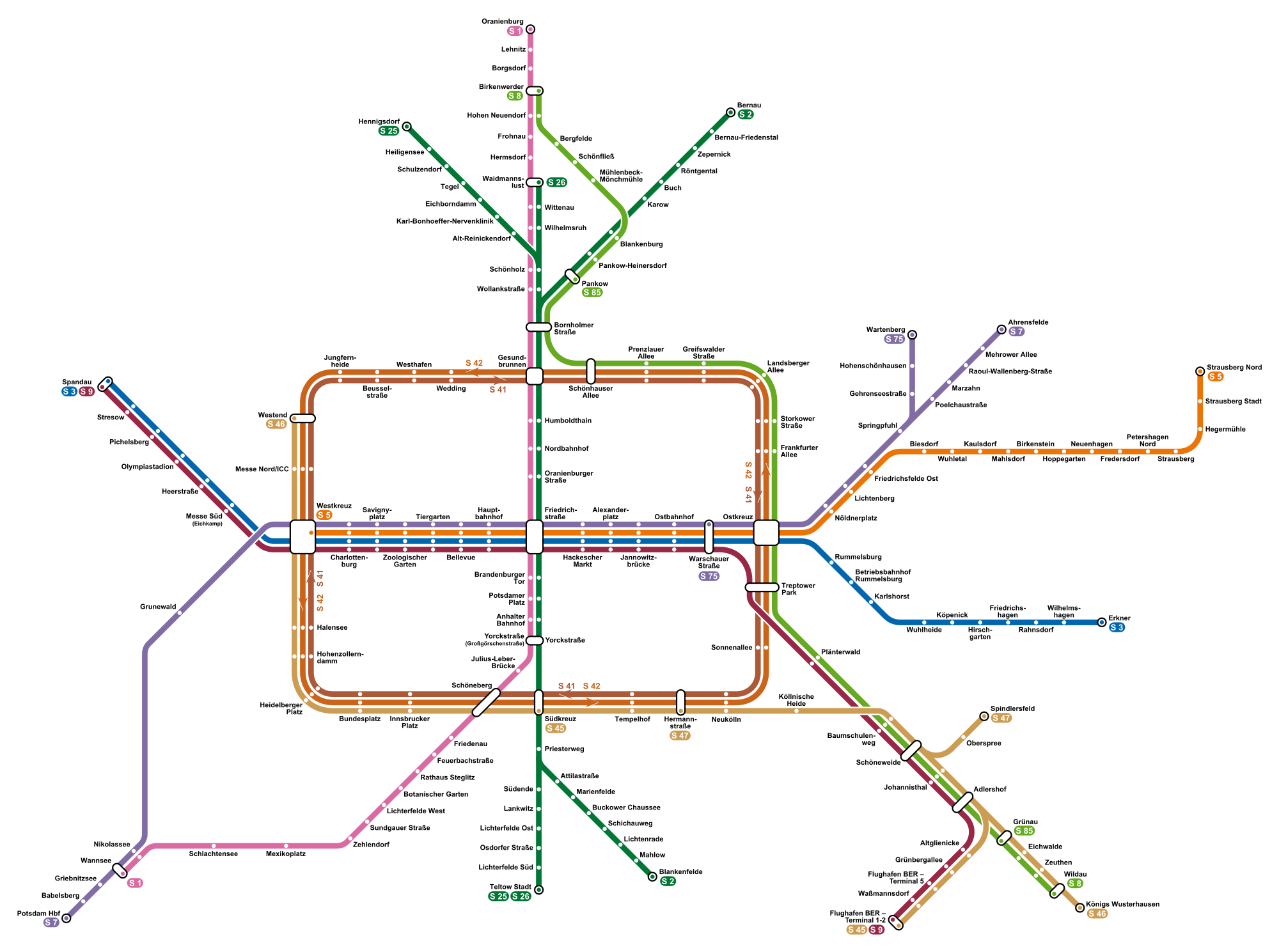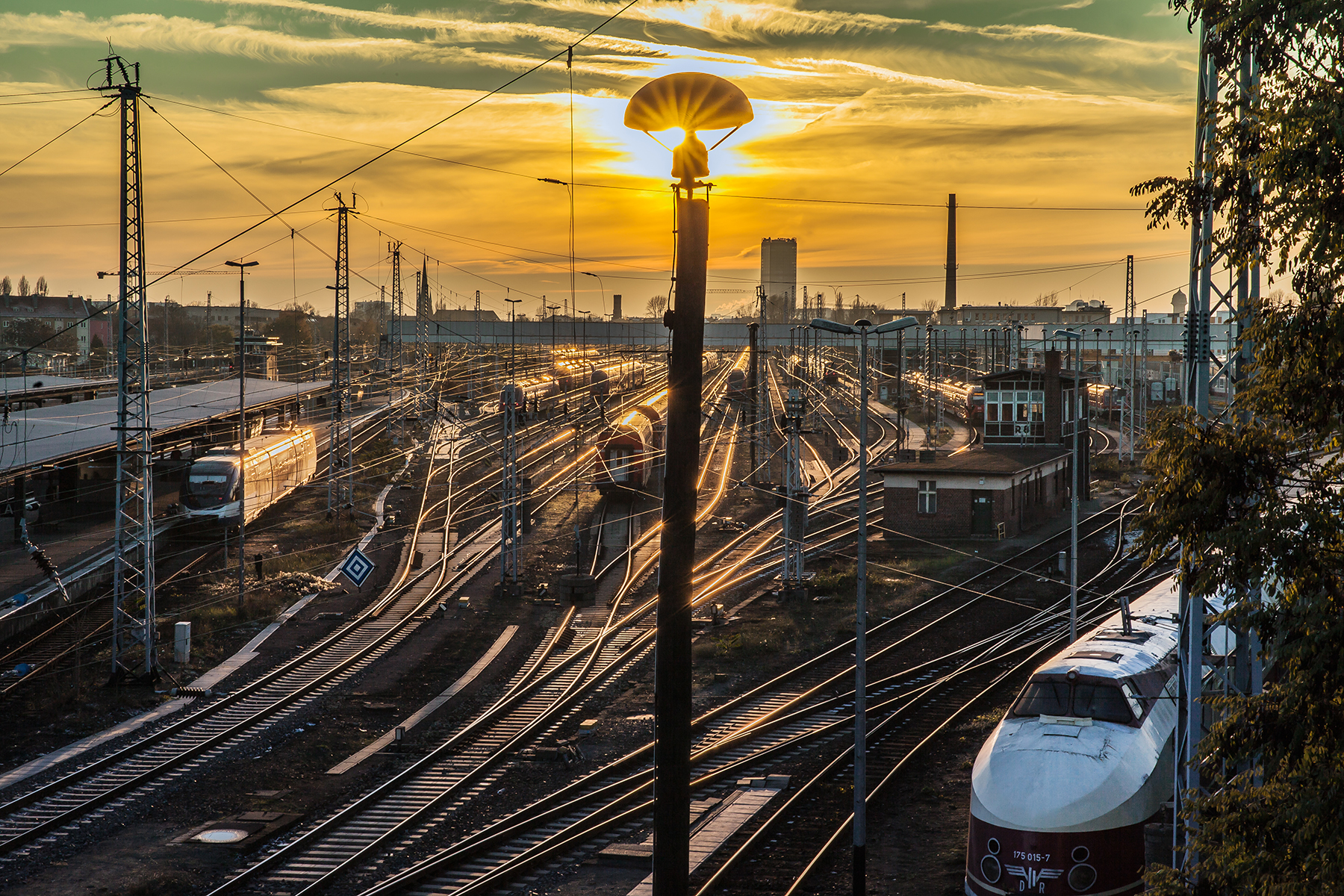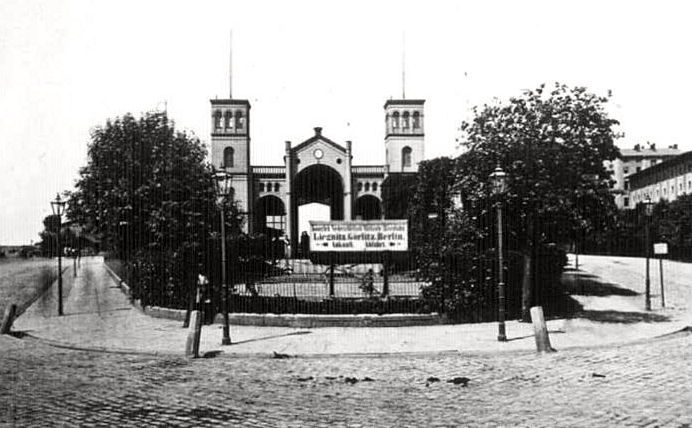|
Ostkreuz
Berlin Ostkreuz station (german: Bahnhof Berlin Ostkreuz) (literally "Berlin East Cross") is a station on the Berlin S-Bahn suburban railway and the busiest interchange station in Berlin. It is in the former East Berlin district of Friedrichshain, now part of the borough of Friedrichshain-Kreuzberg. A smaller part of the station is in Rummelsburg, part of the borough of Lichtenberg. The station is a ''Turmbahnhof'' ("tower station", i.e., a two-level interchange) with the Berlin–Frankfurt (Oder) railway ("Lower Silesian–March Railway") and the Prussian Eastern Railway on the lower level and the Berlin Ringbahn on the upper level. It is used by a total of around 235,000 passengers every day on eight lines, entering or leaving. The station was completely reconstructed from 2006 to December 2018 while operations continued. In the past it was exclusively used as a Berlin S-Bahn station, but it is now also a stopping point for regional services. History A railway crossing po ... [...More Info...] [...Related Items...] OR: [Wikipedia] [Google] [Baidu] |
Berlin S-Bahn
The Berlin S-Bahn () is a rapid transit railway system in and around Berlin, the capital city of Germany. It has been in operation under this name since December 1930, having been previously called the special tariff area ''Berliner Stadt-, Ring- und Vorortbahnen'' (Berlin city, orbital, and suburban railways). It complements the Berlin U-Bahn and is the link to many outer-Berlin areas, such as Berlin Brandenburg Airport. As such, the Berlin S-Bahn blends elements of a commuter rail service and a rapid transit system. In its first decades of operation, the trains were steam-drawn; even after the electrification of large parts of the network, a number of lines remained under steam. Today, the term ''S-Bahn'' is used in Berlin only for those lines and trains with third-rail electrical power transmission and the special Berlin S-Bahn loading gauge. The third unique technical feature of the Berlin S-Bahn, the , is being phased out and replaced by a communications-based train contro ... [...More Info...] [...Related Items...] OR: [Wikipedia] [Google] [Baidu] |
Berliner Ringbahn
The Ringbahn (German for circle railway) is a long circle route around Berlin's inner city area, on the Berlin S-Bahn network. Its course is made up of a double-tracked S-Bahn ring and a parallel freight ring. The S-Bahn lines S41 and S42 provide a closed-loop continuous service without termini. Lines S45, S46 and S47 use a section of the southern and western ring, while lines S8 and S85 use sections of the eastern ring. The combined number of passengers is about 400,000 passengers a day. Due to its distinctive shape, the line is often referred to as the ''Hundekopf'' (Dog's Head). The Ringbahn is bisected by an east–west railway thoroughfare called the Stadtbahn (city railway), which crosses the Ringbahn from Westkreuz (Western Crossing) to Ostkreuz (Eastern Crossing), forming a Südring (Southern Ring) and a Nordring (Northern Ring). The north-south S-Bahn link (with the North-South S-Bahn-tunnel as its central point) divides the Ringbahn into a ''Westring'' (Western Rin ... [...More Info...] [...Related Items...] OR: [Wikipedia] [Google] [Baidu] |
Berlin Frankfurter Allee–Berlin-Rummelsburg Railway
The Berlin Frankfurter Allee–Berlin-Rummelsburg railway is an electrified line in Berlin. It connects the Ringbahn with the Berlin-Betriebsbahnhof Rummelsburg station. Except for a short section, the line has two tracks. It was originally created as a freight line, but it is now used primarily used for the transfer of empty passenger trains that are maintained at the Rummelsburg depot. The track is also linked by a double-track line from the Ringbahn from the south to the Berlin-Lichtenberg station. Route The line branches to the east from the long-distance tracks of the Ringbahn at Berlin Frankfurter Allee junction, about 400 metres south of Frankfurter Allee station after the overpass over Gürtelstraße. From there to Rummelsburg, it runs exclusively on embankments, with a total of nine overpasses over roads, paths and two other railway lines. After about 600 metres, the line, which is elevated on a bridge over the Pfarrstraße, reaches the B1 signalbox at the west end of ... [...More Info...] [...Related Items...] OR: [Wikipedia] [Google] [Baidu] |
Berlin Ringbahn
The Ringbahn ( German for circle railway) is a long circle route around Berlin's inner city area, on the Berlin S-Bahn network. Its course is made up of a double-tracked S-Bahn ring and a parallel freight ring. The S-Bahn lines S41 and S42 provide a closed-loop continuous service without termini. Lines S45, S46 and S47 use a section of the southern and western ring, while lines S8 and S85 use sections of the eastern ring. The combined number of passengers is about 400,000 passengers a day. Due to its distinctive shape, the line is often referred to as the ''Hundekopf'' (Dog's Head). The Ringbahn is bisected by an east–west railway thoroughfare called the Stadtbahn (city railway), which crosses the Ringbahn from Westkreuz (Western Crossing) to Ostkreuz (Eastern Crossing), forming a Südring (Southern Ring) and a Nordring (Northern Ring). The north-south S-Bahn link (with the North-South S-Bahn-tunnel as its central point) divides the Ringbahn into a ''Westring'' (Western ... [...More Info...] [...Related Items...] OR: [Wikipedia] [Google] [Baidu] |
Berlin-Lichtenberg Station
Berlin-Lichtenberg is a railway station in Berlin, Germany. It is located on the Eastern Railway, Wriezen Railway and Berlin Frankfurter Allee–Berlin-Rummelsburg railway lines in the Lichtenberg district. The station is also part of the Berlin S-Bahn and U-Bahn ( line) network. During the division of the city, Lichtenberg with its extended railyards became the central transport facility of East Berlin, together with Berlin Ostbahnhof. Today, the station mainly provides regional rail service to the eastern and northern environs. Overview The station building marks the southeastern border of the Lichtenberg quarter and is primarily accessible from the ''Weitlingstraße'' neighbourhood in the adjacent Rummelsburg locality. North of it, the Frankfurter Allee, part of the Bundesstraße 1/ 5 highway, crosses the tracks on the eight-lane ''Lichtenberger Brücke'' (Lichtenberg Bridge). Until 2006, international trains to Kaliningrad, Warsaw, Kyiv, Minsk, Moscow and Siberia (among ... [...More Info...] [...Related Items...] OR: [Wikipedia] [Google] [Baidu] |
Berlin Ostbahnhof
Berlin Ostbahnhof (German for Berlin East railway station) is a main line railway station in Berlin, Germany. It is located in the Friedrichshain quarter, now part of Friedrichshain-Kreuzberg borough, and has undergone several name changes in its history. It was known as Berlin Hauptbahnhof from 1987 to 1998, a name now applied to Berlin's new central station at the former Lehrter station. Alongside Berlin Zoologischer Garten station it was one of the city's two main stations; however, it has declined in significance since the opening of the new Hauptbahnhof on 26 May 2006, and many mainline trains have been re-routed on the North–South mainline through the new Tiergarten tunnel, bypassing Ostbahnhof. History Early history The station opened on 23 October 1842 as Frankfurter Bahnhof, the terminus of an railway line to Frankfurt (Oder) via Fürstenwalde (Spree). In 1845 the previously independent Berlin–Frankfurt railway merged into the '' Niederschlesisch-Märkische-Eis ... [...More Info...] [...Related Items...] OR: [Wikipedia] [Google] [Baidu] |
Prussian Eastern Railway
The Prussian Eastern Railway (german: Preußische Ostbahn) was a railway in the Kingdom of Prussia and later Germany until 1918. Its main route, approximately long, connected the capital, Berlin, with the cities of Danzig (now Gdańsk, Poland) and Königsberg (now Kaliningrad, Russia). At Eydtkuhnen (now Chernyshevskoye, Russia) it reached the German Empire's border with the Russian Empire. The first part of the line opened in 1851, reaching Eydtkuhnen in 1860. By March 1880 the total route length reached , with a main parallel route in the south via Bromberg (now Bydgoszcz, Poland) and Thorn (now Toruń, Poland) to Insterburg (now Chernyakhovsk, Russia). The lines were the first part of the later Prussian State Railways (german: Preußische Staatseisenbahnen). History From about 1840, the Prussian military urgently sought a railway connection to the Russian border for strategic reasons. The railway was also seen from the early years as a means of developing the underdevel ... [...More Info...] [...Related Items...] OR: [Wikipedia] [Google] [Baidu] |
Rummelsburg
Rummelsburg () is a subdivision or neighborhood (''Ortsteil'') of the borough (''Bezirk'') of Lichtenberg of the German capital, Berlin. History Rummelsburg was founded in 1669. On 30 January 1889 it became a rural municipality, with the name of Boxhagen-Rummelsburg. Merged in 1912 in the town of Lichtenberg, in 1920 it was incorporated in Berlin with the ''Greater Berlin Act''. Geography Overview Located in the eastern side of the city and crossed by Spree river in the western corner, Rummelsburg borders with Lichtenberg, Friedrichsfelde, Karlshorst, Friedrichshain (in Friedrichshain-Kreuzberg district), Plänterwald and Oberschöneweide (both in Treptow-Köpenick district). The lake Rummelsburger See belongs to the locality and separates it from Stralau, a zone of Friedrichshain. Subdivision Rummelsburg counts 1 zone (''Ortslage''): * Victoriastadt Transport The locality is served by several urban rail lines of ''S-Bahn'' and ''U-Bahn''. The stations serving the locality a ... [...More Info...] [...Related Items...] OR: [Wikipedia] [Google] [Baidu] |
Berlin Stadtbahn
The Berlin Stadtbahn ("city railway") is a major railway thoroughfare in the German capital Berlin, which runs through Berlin from east to west. It connects the eastern district of Friedrichshain with Charlottenburg in the west via 11 intermediate stations including Hauptbahnhof. The Berlin Stadtbahn is often also defined as the slightly longer route between Ostkreuz and Westkreuz, although this is not technically correct. The line was originally built in the 1880s. It is in length, and is entirely elevated above the city's streets. The four track route carries S-Bahn, Regionalbahn, Regional-Express, Intercity, EuroCity and Intercity-Express trains. Operation Structure and tracks The Stadtbahn line is an elevated rail line with viaducts totalling in length and including 731 masonry viaduct arches. A further of the line are situated on 64 bridges, that cross adjoining streets and (three times) the River Spree. The remaining length of the line is on an embankm ... [...More Info...] [...Related Items...] OR: [Wikipedia] [Google] [Baidu] |
Berlin-Rummelsburg Betriebsbahnhof Station
Berlin-Rummelsburg Betriebsbahnhof station is a former freight yard, currently used as a ''Betriebsbahnhof'' (“operations station”), in the suburb of Rummelsburg in the Lichtenberg district of Berlin. It is primarily used as a depot for the storage and maintenance of passenger train sets used for long-distance traffic. In particular, InterCity Express trains terminating in Berlin are stored there. Deutsche Bahn officially call the station ''Berlin-Rummelsburg'', but it is not to be confused with the more westerly Berlin-Rummelsburg S-Bahn station. The S-Bahn section of the precinct is called ''S-Bahnhof Betriebsbahnhof Berlin-Rummelsburg'' (Berlin-Rummelsburg operations station S-Bahn station), which is classifies as a ''Haltepunkt'' (a “halt”, that is it has no sets of points). It is served by S-Bahn line . Location The station is located on the Berlin-Frankfurt (Oder) railway (“Lower Silesian–Markish Railway”) between the S-Bahn Berlin-Rummelsburg station and ... [...More Info...] [...Related Items...] OR: [Wikipedia] [Google] [Baidu] |
Berliner Stadtbahn
The Berlin Stadtbahn ("city railway") is a major railway thoroughfare in the German capital Berlin, which runs through Berlin from east to west. It connects the eastern district of Friedrichshain with Charlottenburg in the west via 11 intermediate stations including Hauptbahnhof. The Berlin Stadtbahn is often also defined as the slightly longer route between Ostkreuz and Westkreuz, although this is not technically correct. The line was originally built in the 1880s. It is in length, and is entirely elevated above the city's streets. The four track route carries S-Bahn, Regionalbahn, Regional-Express, Intercity, EuroCity and Intercity-Express trains. Operation Structure and tracks The Stadtbahn line is an elevated rail line with viaducts totalling in length and including 731 masonry viaduct arches. A further of the line are situated on 64 bridges, that cross adjoining streets and (three times) the River Spree. The remaining length of the line is on an embankment. ... [...More Info...] [...Related Items...] OR: [Wikipedia] [Google] [Baidu] |
Berlin–Wrocław Railway
The Berlin–Wrocław railway (german: Niederschlesisch-Märkische Eisenbahn-Gesellschaft, roughly translating as "Lower Silesian-Marcher Railway", NME) was a German private railway that connected Berlin (then capital of the March of Brandenburg, ''Mark Brandenburg'') and Wrocław (in Lower Silesia, then part of Prussia, and called Breslau in German, now in Poland). It is one of the oldest lines in Germany, opened between 1842 and 1847 and acquired by the Prussian government in 1852. In 1920, it became part of the German national railways along with the rest of the Prussian state railways. History Beginning Around 1840 all the major countries of the German Confederation began to build main-line railways. From 1837 to 1839, the first German long-distance railway was built in Saxony, the Leipzig–Dresden railway. In 1837 Austria began building its Northern Railway. From 1838 to 1840 the first railways crossing state boundaries (the Magdeburg–Leipzig railway and the Anhalt ... [...More Info...] [...Related Items...] OR: [Wikipedia] [Google] [Baidu] |








